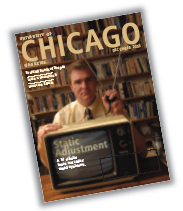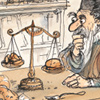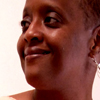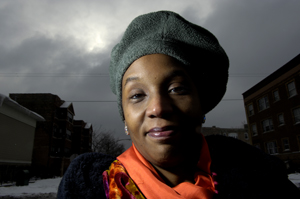|
||
      |
Letters: Much as I hesitate to criticize a former president...
 Missing
Ingredients
Missing
Ingredients
The anonymous author of your article on the latke-hamentashen debate (“Shticking to Their Puns,” December/05) has committed several errors of omission and commission. It begins by stating that the debate “always” takes place in Mandel Hall; but in the 20-odd years I attended it (between 1972 and 1996—a few times, the University Chorus rehearsal absolutely could not be missed), it “always” took place in Ida Noyes Hall, usually in a packed Cloister Club, and latterly in the sterile environment of the Max Palevsky Cinema.
Presenters did not decamp post-debate to a Hutch Commons “reception” but rather to a Hillel House free-for-all to sample the delicacies.
Unmentioned go the founder of the event, anthropologist Sol Tax, PhD’35; Hillel’s late Rabbi Danny Leifer, who annually expounded on the gematria of the year and current events; the annual “token goy” who joined the otherwise Jewish lineup of experts on either side; and the always-impartial moderator (for many years, linguistics professor Howie Aronson).
Peter T. Daniels, AM’83
Jersey City, New Jersey
 Much
as I hesitate to criticize a former president of my alma mater, as a student
of Leo Strauss and author of books on Machiavelli, I must take strong exception
to the republication of Hanna Holborn Gray’s 1991 contribution to
the ongoing latke-hamantashen debate (December/05, p. 43). Not only was
Machiavelli never a single-minded supporter of the latke, but her claim
that silence on his preference proves Machiavelli was a secret Jew ignores
the rigor of Straussian analysis. Yet Allan Bloom, PhB’49, AM’53,
PhD’55—my dear friend and an authentic Straussian whose contribution
is also republished (p. 42)—saw clearly the Freudian symbolism of
latke (female sexual object) and hamantashen (male sexual object).
Much
as I hesitate to criticize a former president of my alma mater, as a student
of Leo Strauss and author of books on Machiavelli, I must take strong exception
to the republication of Hanna Holborn Gray’s 1991 contribution to
the ongoing latke-hamantashen debate (December/05, p. 43). Not only was
Machiavelli never a single-minded supporter of the latke, but her claim
that silence on his preference proves Machiavelli was a secret Jew ignores
the rigor of Straussian analysis. Yet Allan Bloom, PhB’49, AM’53,
PhD’55—my dear friend and an authentic Straussian whose contribution
is also republished (p. 42)—saw clearly the Freudian symbolism of
latke (female sexual object) and hamantashen (male sexual object).
What Bloom did not bother to explain was Freud’s influence on Machiavelli, whose bisexuality explains his silence. After his failed collaboration with Leonardo, which proved to them both the dangers of making public the scientific explanation of religion, old Nick sought to encourage the latke-hamantashen debate as a way of hiding Freud’s discovery that both heterosexual and homosexual pleasures are products of intelligent design. Continuing the tradition of this debate is therefore an obligation of the faculty, staff, and alumni of the University and an important contribution to this magazine.
Roger D. Masters, AM’58, PhD’61
White River Junction, Vermont
More food for thought
The latke-hamantashen debate article, “Shticking to Their Puns,” was marvelous. Now I offer another debate concerning these delights: are they Jewish or East European? I am not Jewish but grew up eating both—one with applesauce or sour cream depending on my mood—because my background is East European Christian. Would Northern, Southern or Western European—Jews or Christians—be familiar with these treats?
Irene Jankowski
New York City
Error evokes epigraph
I noted with sadness the obituary for Professor Clyde A. Hutchison Jr. published in the December/05 issue. Clyde had a keen sense of humor and a penchant for accuracy. He also liked to have his name spelled correctly. He would say: “There is an ‘n’ in my name, but it is at the end.”
Maurice Griffel, PhD’49
Albany, New York
Rating the rating game
 I
am told that a famous professor in the College was asked during the 1960s
what he thought of the student protests occurring at the time. “You
pays your nickel, now you takes your ride,” was the reported response.
I thought of that story when reading “The
Rating Game” (“Chicago Journal,” October/05). I wonder
what this professor would have thought of students rating their teachers.
I
am told that a famous professor in the College was asked during the 1960s
what he thought of the student protests occurring at the time. “You
pays your nickel, now you takes your ride,” was the reported response.
I thought of that story when reading “The
Rating Game” (“Chicago Journal,” October/05). I wonder
what this professor would have thought of students rating their teachers.
It seems that every educational institution from middle schools (or below) through graduate schools are encouraging students to write evaluations of their teachers. Although I have read much about these evaluations, I have read no scholarly study of whether they do any good or if, in fact, they cause harm. Most disturbingly, I have seen nothing about attempts to analyze whether they have built-in prejudices that could distort their results. A topic such as this deserves much more review than a simple letter to the editor. In the true U of C tradition, however, I do want to put on the table some disturbing questions:
Conflict of interest: Students are worried about grades and how much of their free time is taken up with out-of-class assignments. Do they rate faculty to some extent based on the grades they expect and on how burdensome they feel the assignments are? Do other factors besides the quality of their education affect their ratings?
Dislike of the subject matter: College is a time to try new areas of study. Many students find they are not really interested in a class once they delve into the subject matter. Are students who may rate a professor boring actually finding the subject matter a “yawner” and marking down the teacher because of it?
Sherry/schmooze factor: Certain faculty used to come to dormitory sherry hours and wittily shoot the breeze or spent class giving interesting anecdotes. They were quite popular. Other faculty were less fun but great teachers. Are students evaluating presentation styles, content, how much they like the professor, or what? Do professors with friendlier personalities do better in ratings than those who are less outgoing?
If educational institutions are using student ratings to decide on tenure and other issues of importance, a scholarly evaluation of student ratings is important. If the ratings are being used solely by students to decide which faculty will entertain them the most, then perhaps my concerns are ill-founded.
Alan Bloom, AB’68
Manhattan Beach, California
One in spirit, not in opinion
Thank you for producing such an outstanding magazine. It is a pleasure to read, especially the articles about faculty members’ research. I have been meaning to commend you and your staff for some time, and a peculiar event finally triggered this letter.
A few days ago, I found three unread issues of varying age and started reading them. The February/04 issue particularly aroused my interest. The article “Full Speed Ahead,” a review of Lynn Margulis’s life and work, was outstanding. I thought it the equal of a few such articles you publish each year.
Then I looked at the letters to the editor. The principal topic was criticism of “Zone of Contention” (December/03) by Soo Ji Min, an article I did not read in an issue I have long since discarded. Would the negative critics have harsh comments on the view of Margulis as well? But more to the point, to do your work as editor, you must include controversial topics. The lively letters of “Zone of Contention” attest to your success.
I have seen multiple issues of a few other alumni magazines, only one of which (Brandeis) even attempts such an article, with much less frequency.
Thank you for publishing this wonderful magazine.
George W. Gross, AB’54, AM’64
Chicago
Everything new is old again
Re: Lauren Gaudino’s letter in the December/05 edition: Lighten up and stop fussing. The New Yorker’s caption contest is old hat. Linn’s Stamp News (a weekly for philatelists and others) has been running caption contests for years. The idea is far from fresh with the New Yorker and probably predates us all, in all sorts of publications. A bit of humor now and then won’t hurt much of anyone, and this was a good opportunity.
The magazine is just fine; I don’t always agree with the all of positions taken, but that is what Chicago was all about. Even this letter is evidence of that.
Collyer Church, JD’60
Bainbridge Island, Washington
Legal landmark
Ben Manaster’s criticism of Brown v. Board of Education (“Letters,” December/05) has some merit in regard to both Brown’s legal assumptions and its immediate social effects, but his scorn is not justified. Brown stands as a fundamental landmark. Following reasoning that had earlier overturned segregation of public legal education in Texas, Brown firmly established the principle that segregation is inherently unequal and formed the bedrock basis for progress toward equal protection of the law throughout society.
Bill Williamson, PhD’59
Madison, Wisconsin
I usually refrain from writing letters commenting on letters, but Ben Manaster’s letter begs a rejoinder. Mr. Manaster attacks Brown v. Board of Education as “abominably wrought” and goes on to imply that the Brown decision has led to degraded public schools and, in turn, to the destruction of Hyde Park and South Shore as “vibrant, integrated communities.” I grew up in Hyde Park and attended its integrated public schools (Murray, Harte, and Kenwood). Integration had upsides and downsides, but in retrospect the positive experience of diversity outweighed the negatives. I seem to have received sufficient book larnin’ in those integrated public schools, for I made it into the U of C and was graduated Phi Beta Kappa. For what it’s worth, I have practiced constitutional litigation for a decade and a half and have not encountered the universal contempt for Brown Mr. Manaster claims is out there.
I go back to Hyde Park regularly and still read the Hyde Park Herald, and although the community still seems “vibrant [and] integrated,” I agree there also appears to be significantly more crime and hooliganism than when I was growing up. Some of the barbarity does appear linked to local students. But it seems likely that the cause of these problems is isolation and lack of diversity (along class as well as racial lines, and in housing as well as classrooms), not integration following Brown. Given Mr. Manaster’s graduation date [1959], he would appear to have largely avoided the horrors of school integration, yet his own education nevertheless seems a tad deficient—at least with respect to social theory, knowledge of urban history, and elementary causal reasoning.
Andrew S. Mine, AB’81
Chicago
Legal argument
 I
want to thank Eleanor P. Simpson, AB’65, for her informative letter
(“Letters,” December/05)
commenting on Meredith Meyer’s article “Scarpe
Diem” (“Chicago Journal,” October/05). It is very
re-assuring to know that Clint Bolick “had been most closely associated
with attacks on affirmative action,” for the attacks are clearly just.
Ms. Simpson apparently does not consider the fact that in every instance
of “affirmative action” there is a victim, namely the person
or entity whose entitlement or benefit was denied by the affirmative action.
Affirmative action is, by definition discriminatory, and it is of negative
value to its beneficiaries to boot. But then again if you have an AB from
Chicago and the only sources you cite in support of your premise are the
slanted opinions of the New York Times editorial board and Right
Watch, you have probably not read or been exposed to Frederick Hayek, Aaron
Director, and Milton Friedman, AM’34. In my experience a person with
an incomplete education often lacks the ability to critically evaluate the
sources of his information leading him to adopt fuzzy conclusions and deluding
him into believing (no doubt in earnest) that he above others knows what
is best for society. That is, he becomes a dedicated social engineer with
the ability to decide who to discriminate in favor of and against by his
affirmative action.
I
want to thank Eleanor P. Simpson, AB’65, for her informative letter
(“Letters,” December/05)
commenting on Meredith Meyer’s article “Scarpe
Diem” (“Chicago Journal,” October/05). It is very
re-assuring to know that Clint Bolick “had been most closely associated
with attacks on affirmative action,” for the attacks are clearly just.
Ms. Simpson apparently does not consider the fact that in every instance
of “affirmative action” there is a victim, namely the person
or entity whose entitlement or benefit was denied by the affirmative action.
Affirmative action is, by definition discriminatory, and it is of negative
value to its beneficiaries to boot. But then again if you have an AB from
Chicago and the only sources you cite in support of your premise are the
slanted opinions of the New York Times editorial board and Right
Watch, you have probably not read or been exposed to Frederick Hayek, Aaron
Director, and Milton Friedman, AM’34. In my experience a person with
an incomplete education often lacks the ability to critically evaluate the
sources of his information leading him to adopt fuzzy conclusions and deluding
him into believing (no doubt in earnest) that he above others knows what
is best for society. That is, he becomes a dedicated social engineer with
the ability to decide who to discriminate in favor of and against by his
affirmative action.
Don Padgitt, JD’59
Winnetka, Illinois
The clinic's record
Eleanor P. Simpson, AB’65, wrote criticizing the Magazine for its “favorable, or at least neutral” account of the assistance provided to a local entrepreneur by the Institute for Justice Clinic on Entrepreneurship at the Law School. Ms. Simpson insists the Magazine should have relied on quotes about IJ and its associates that she found on partisan Web sites instead of IJ’s actual record. The IJ Clinic has consistently represented poor and politically disenfranchised clients in their battles to keep their homes or make a living. The IJ Clinic at the Law School helps low-income Chicagoans navigate the complex legal questions that arise when running even the smallest business. In various projects, IJ has partnered with foundations from across the political spectrum and local chapters of the NAACP, besides the University of Chicago. These are the facts that reliable research would reveal. Ms. Simpson and all Chicago alumni are welcome to call or visit and discover what we really do.
Elizabeth Milnikel
Director, Institute for Justice Clinic on Entrepreneurship
More on id
I was profoundly disturbed by the level of inanity and fuzzy thinking coming out of U of C graduates, as evidenced by two consecutive months of responses to Samuel Scheiner’s letter about the intelligent design controversy. I thought the U of C did a better job with science education. Lew Flagg’s that evolution is a “philosophical theory” is only correct insofar as science is, itself, merely a philosophical theory. Evolution is as much a scientific fact as gravity. What is theoretical are the exact mechanisms for the observed evolution, now and in the past. Science is an approach to finding truth that relies first and foremost on natural explanations. Any explanation that relies on the supernatural is ipso facto not science. What is often ignored by nonscientists and the ill-educated is that a “theory” in science is a systematic and formalized expression of all previous observations made; it must be predictive, logical, testable, and falsifiable.

Sonya Malunda, assistant vice president and director of the University's
Community Affairs office, works with Woodlawn residents ("Due
South").
A major fallacy of the intelligent design crowd, since their original proponent, the Reverend Paley (1802), has been that the biological world is “designed.” Granted, there is considerable complexity, but such complexity does not necessarily require a purpose or a designer. If complexity is sufficient evidence of design, what then of the patterns produced by a pile of pick-up stix, scattered from a tube onto the living-room floor? And the so-called “design” in living creatures is far from flawless—why are humans plagued with so many lower back problems and prolapsed uteruses? And, what is the point of the appendix? Do these point to an inept Designer? Or, is it more likely that humans evolved from an ancestral species that walked on four legs (for the former two common human physical complaints) or that had cellulose in its diet (in the case of the appendix)? If there were a Designer, from whence did it come? Was it an extraterrestrial, as suggested by Mr. Flagg’s reference to SETI? Or was the Designer of a more heavenly sort? Either way, there’s little testable in these “hypotheses” and, in the latter case, we’ve left the realm of science altogether.
I noticed that both letter writers received their MBAs from U of C. To give the University the benefit of the doubt, let’s assume these graduates were not properly schooled in science prior to joining the University in the Business School. That might explain why one writer “just don’t get it.” As mentioned earlier, science plays by certain rules. So let’s try this analogy. Imagine someone trying to define a “free market” where the government controls every aspect of pricing and production. What? Doesn’t fit the accepted definition? That’s the problem with intelligent design (aka creationism)—it’s just not science.
Mike Perlin, AB’78, SM’80, PhD’83
Louisville, Kentucky
In his comment about intelligent design, Stephen M. Obeda, MBA’97, writes (“Letters,” October/05) that “Nobody whom I have ever met in my entire life has claimed that fossils were put there by God ‘to test our faith.’ Nobody. Ever.” I could send Obeda a dozen names of creationists whom I know personally who claim precisely that.
I am an orthodox Jew and a professional scientist who believes that the Book of Genesis is the word of God. However, this belief does not require me to be a creationist or to understand every word in Genesis literally. God speaks in allegories and often uses figurative language, as the great Jewish scholar Maimonides emphasized 800 years ago (“Guide for the Perplexed,” 2:25). Therefore the existence of multimillion-year-old fossils in no way contradicts my religious belief that God created the universe, including the animal kingdom, as stated in Genesis. What science has shown is that evolution is the mechanism that God used to form the animal kingdom, as Darwin himself stated in the last sentence of his famous book, On the Origin of Species.
My point is that it is not necessary to check one’s brains at the door before entering a synagogue or a house of religious study. It is not a matter of science or Genesis, but rather science and Genesis.
Nathan (Wiser) Aviezer, SM’59, PhD’65
Petach Tikva, Israel
Black and white and read
I really enjoy reading the University of Chicago Magazine, especially those pages I can read more easily, i.e. those without colorful graphics that reduce contrast—often substantially.
Is there something wrong with black type on white pages? Such pages would be more readable and no doubt cost less to print. But most magazines do this nowadays, no doubt since there are now more graphic designers who are gainfully employed.
Many Magazine readers are seniors. I suspect there are many who share my thoughts on this. My guess also is that most magazine designers are young persons who have no conception of increasing visual limitations as one grows older. And my eyesight fortunately is fairly good with glasses. When I see pages so colorfully dolled up I just go to the next page I can more easily read!
Joe Marlin, AM’54, AM’60
Chicago
Transcript fees
In December 2005, when applying to graduate schools, I discovered that the U of C has a new system for processing the transcript requests of its alumni. For those who don’t yet know, this work has been outsourced to the National Student Clearinghouse based in Virginia. At the same time, the U of C has instituted a “Lifetime Transcript Fee” for current and returning students, meaning that as of autumn 2005 these students can receive an unlimited number of transcripts for a one-time fee of $25–$35. While I object neither to the U of C outsourcing transcript orders nor to the flat fee current and future students are charged—both moves make much sense—I do take exception to the fact that alumni must still pay $12 per transcript. This sum is simply unreasonable and far above what most institutions charge. Two examples: Harvard, where I earned an EdM, charges just $2 per transcript for most of its degree programs; Amherst College, where I earned my BA, charges nothing. The U of C should immediately review and revise what it charges alumni for transcripts.
I, for one, am a far more generous donor to the institutions where I’ve studied when those institutions treat me well; the money Amherst doesn’t make on me from transcripts I donate to its annual fund. The U of C could learn something from its peer institutions. Charging $12 per transcript is outrageous and insulting, not to mention an abuse of the school’s monopoly on the transcripts of its alumni.
Justin Snider, AM’00
Vienna, Austria
University Registrar Thomas C. Black responds: Alumni can pay the $35 lifetime transcript fee and receive the same benefits as students; that is, transcripts for life. This is being offered on a person-to-person basis, inasmuch as we don’t have the capacity to handle this program—and process these orders—manually. The Clearinghouse is reprogramming the order site in order to make the offer routinely available, but we’ve offered this to anyone who raises the question about our program. The Clearinghouse promises to have the programming in place in February.
[For the latest information on the transcript program, go to: registrar.uchicago
.edu/transcripts.html.—Ed.]
Elegy for education
Alumni of the University of Chicago’s famous, but now defunct, Department of Education continue to lament its termination. Consequently it was gratifying to see, in the online Columbia Encyclopedia’s short, six-sentence entry about the University of Chicago, that the final sentence with great irony reads: “Significant among the university’s graduate and research facilities are the Pritzker School of Medicine; the Enrico Fermi Institute and the Enrico Fermi National Accelerator Laboratory; the Argonne National Laboratory; the Yerkes Observatory, at Williams Bay, Wis.; the Oriental Institute; and the former school of education (closed in 1997).” Too bad the U of C administration did not think as highly of the education department as did experts around the world and the authors of the Columbia Encyclopedia!
William Lowe Boyd, PhD’73
University Park, Pennsylvania
Author's query
I am at work on a biography of J. Harlen Bretz, PhD’13. As a professor of geology at Chicago, Bretz turned the geological world upside down with his 1920s theory on how some 15,000 square miles of the inland Pacific Northwest was carved into complex canyons, coulees, rock, mesas, and deep pothole lakes.
I seek personal recollections from his students (Bretz taught at the U of C from the teens to 1947) and invite anyone who studied under Bretz, accompanied him on field trips, or otherwise had contact with him, to contact me by e-mail: emuranch1@netzero.com; phone: 509/235-2057; or mail: P.O. Box 501, Cheney, WA 99004.
John Soennichsen
Cheney, Washington
The University of Chicago Magazine welcomes letters about its contents or University issues. Letters for publication must be signed and may be edited for clarity and space. We encourage letters of 300 words or less. Write: Editor, University of Chicago Magazine, 5801 S. Ellis Avenue, Chicago, IL 60637. Or e-mail: uchicago-magazine@uchicago.edu.